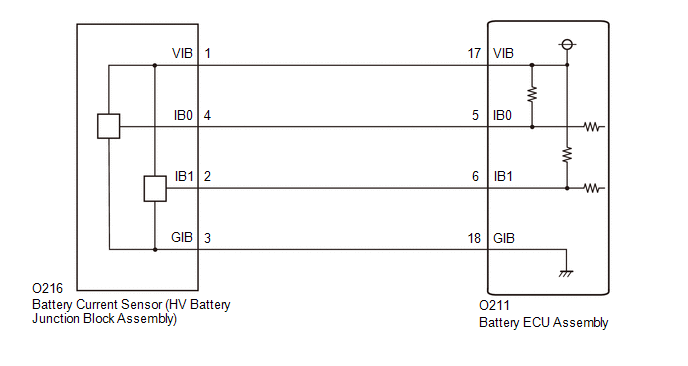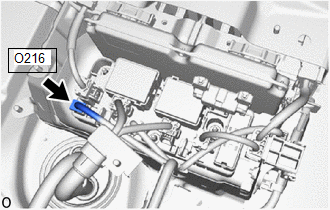Toyota Corolla Cross: Hybrid/EV Battery Current Sensor "A" Circuit Range/Performance (P0ABF00)
DESCRIPTION
A battery current sensor, which is mounted on the positive cable side of each HV battery junction block assembly, detects the current flowing to or from the battery pack. The battery current sensor sends a voltage, which varies between 0 and 5 V in proportion to the amperage, to the IB0 terminal of the battery ECU assembly. Similarly, it sends a voltage, which varies between 0 and 5 V in inverse proportion to the amperage, to the IB1 terminal of the battery ECU assembly. When the voltage at the IB0 terminal is below 2.92 V and the voltage at the IB1 terminal is above 2.08 V, this indicates that the HV battery is being discharged. Additionally, Meanwhile, when the voltage at of the IB0 terminal is above 2.92 V and the voltage at of the IB1 terminal is below 2.08 V, this indicates that the HV battery is being charged. The battery ECU assembly sends the signals from its IB0 and IB1 terminals to the hybrid vehicle control ECU. The hybrid vehicle control ECU determines the charging and discharging amperage of the HV battery based on the received signals and calculates the SOC of the HV battery using the cumulative amperage value.
.png)
|
DTC No. | Detection Item |
DTC Detection Condition |
Trouble Area | MIL |
Warning Indicate | Note |
|---|---|---|---|---|---|---|
|
P0ABF00 | Hybrid/EV Battery Current Sensor "A" Circuit Range/Performance |
Abnormal battery current sensor characteristics: (based on hybrid system consumption and HV battery output). (1 trip detection logic) |
| Comes on |
Master Warning: Comes on |
SAE Code: P0AC0 |
MONITOR DESCRIPTION
The hybrid vehicle control ECU detects malfunctions of the battery current sensor by monitoring motor and generator torque. If the hybrid vehicle control ECU detects a battery current sensor malfunction, the hybrid vehicle control ECU will illuminate the MIL and store a DTC.
MONITOR STRATEGY
|
Related DTCs | P0AC0 (INF P0ABF00): Current sensor malfunction (gain or offset) |
|
Required sensors/components | Battery current sensor |
|
Frequency of operation | Continuous |
|
Duration | TMC's intellectual property |
|
MIL operation | 1 driving cycle |
|
Sequence of operation | None |
TYPICAL ENABLING CONDITIONS
|
The monitor will run whenever the following DTCs are not stored |
TMC's intellectual property |
|
Other conditions belong to TMC's intellectual property |
- |
TYPICAL MALFUNCTION THRESHOLDS
|
TMC's intellectual property | - |
COMPONENT OPERATING RANGE
|
Hybrid vehicle control ECU | DTC P0AC0 (INF P0ABF00) is not detected |
CONFIRMATION DRIVING PATTERN
HINT:
- After repair has been completed, clear the DTC and then check that the vehicle has returned to normal by performing the following All Readiness check procedure.
Click here
.gif)
Click here
.gif)
- When clearing the permanent DTCs, refer to the "CLEAR PERMANENT DTC" procedure.
- Connect the GTS to the DLC3.
- Turn the ignition switch to ON and turn the GTS on.
- Clear the DTCs (even if no DTCs are stored, perform the clear DTC procedure).
- Turn the ignition switch off and wait for 2 minutes or more.
- Turn the ignition switch to ON and turn the GTS on.
- Drive the vehicle for approximately 10 minutes according to the Freeze Frame Data items "Vehicle Speed", "Accelerator Position", "Hybrid/EV Battery Current", "Motor Torque" and "Generator Torque". [*1]
HINT:
[*1]: Normal judgment procedure.
The normal judgment procedure is used to complete DTC judgment and also used when clearing permanent DTCs.
- Enter the following menus: Powertrain / Hybrid Control / Utility / All Readiness.
- Check the DTC judgment result.
HINT:
- If the judgment result shows NORMAL, the system is normal.
- If the judgment result shows ABNORMAL, the system has a malfunction.
- If the judgment result shows INCOMPLETE, perform the normal judgment procedure again.
WIRING DIAGRAM

CAUTION / NOTICE / HINT
CAUTION:
Refer to the precautions before inspecting high voltage circuit.
Click here .gif)
NOTICE:
- After the ignition switch is turned off, there may be a waiting time before disconnecting the negative (-) auxiliary battery terminal.
Click here
.gif)
- When disconnecting and reconnecting the auxiliary battery
HINT:
When disconnecting and reconnecting the auxiliary battery, there is an automatic learning function that completes learning when the respective system is used.
Click here
.gif)
PROCEDURE
|
1. | CHECK HARNESS AND CONNECTOR (BATTERY ECU ASSEMBLY - HV BATTERY JUNCTION BLOCK ASSEMBLY) |
CAUTION:
Be sure to wear insulated gloves and protective goggles.
(a) Check that the service plug grip is not installed.
NOTICE:
After removing the service plug grip, do not turn the ignition switch to ON (READY), unless instructed by the repair manual because this may cause a malfunction.
| (b) Disconnect the battery ECU assembly connector. NOTICE: Before disconnecting the connector, check that it is not loose or disconnected. |
|
| (c) Disconnect the battery current sensor connector from the HV battery junction block assembly. NOTICE: Before disconnecting the connector, check that it is not loose or disconnected. |
|
(d) Measure the resistance according to the value(s) in the tables below.
Standard Resistance (Check for Open):
|
Tester Connection | Condition |
Specified Condition |
|---|---|---|
|
O211-6 (IB1) - O216-2 (IB1) |
Ignition switch off |
Below 1 Ω |
|
O211-18 (GIB) - O216-3 (GIB) |
Ignition switch off |
Below 1 Ω |
|
O211-5 (IB0) - O216-4 (IB0) |
Ignition switch off |
Below 1 Ω |
|
O211-17 (VIB) - O216-1 (VIB) |
Ignition switch off |
Below 1 Ω |
Standard Resistance (Check for Short):
|
Tester Connection | Condition |
Specified Condition |
|---|---|---|
|
O211-6 (IB1) or O216-2 (IB1) - Other terminals and body ground |
Ignition switch off |
10 kΩ or higher |
|
O211-18 (GIB) or O216-3 (GIB) - Other terminals and body ground |
Ignition switch off |
10 kΩ or higher |
|
O211-5 (IB0) or O216-4 (IB0) - Other terminals and body ground |
Ignition switch off |
10 kΩ or higher |
|
O211-17 (VIB) or O216-1 (VIB) - Other terminals and body ground |
Ignition switch off |
10 kΩ or higher |
(e) Reconnect the battery current sensor connector to the HV battery junction block assembly.
(f) Reconnect the battery ECU assembly connector.
| NG | .gif) | REPLACE HV BATTERY |
|
|
2. | REPLACE HV BATTERY JUNCTION BLOCK ASSEMBLY |
Click here .gif)
|
|
3. | CLEAR DTC |
Click here
.gif)
|
|
4. | PERFORM ROAD TEST |
(a) Check that "Hybrid/EV Battery SOC" shows 60% or less.
Powertrain > Hybrid Control > Data List|
Tester Display |
|---|
|
Hybrid/EV Battery SOC |
HINT:
If "Hybrid/EV Battery SOC" is 60% or more, reduce it to below 60% by leaving the hybrid system on with shift lever in N.
(b) Apply the parking brake and secure the wheels using chocks.
(c) Turn the ignition switch to ON (READY).
(d) Move the shift lever to D while depressing the brake pedal with your left foot and repeat the following steps for 1 minute or more.
HINT:
Depress and release the accelerator pedal in 5-second intervals (2.5 seconds each) continuously.
(1) While depressing the brake pedal with your left foot, depress the accelerator pedal with your right foot.
(2) Release the accelerator pedal.
(e) Turn the ignition switch off.
|
|
5. | CHECK DTC OUTPUT (HYBRID CONTROL) |
(a) Check for DTCs.
Powertrain > Hybrid Control > Trouble Codes|
Result | Proceed to |
|---|---|
|
P0ABF00 is not output. |
A |
| P0ABF00 is output again. |
B |
(b) Turn the ignition switch off.
| A | .gif) | END |
| B | .gif) | REPLACE BATTERY ECU ASSEMBLY |

.png)

.gif)

